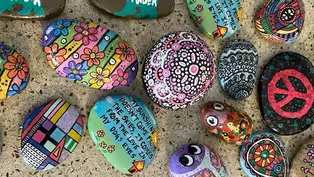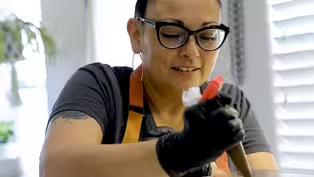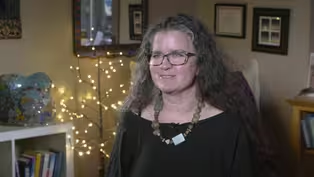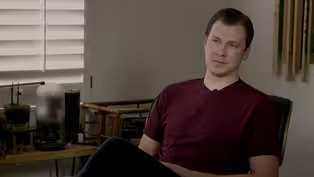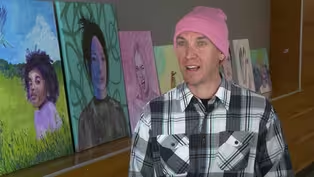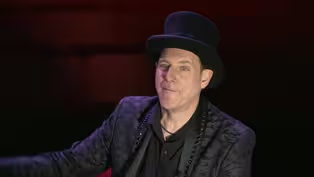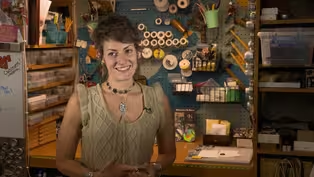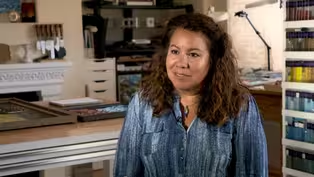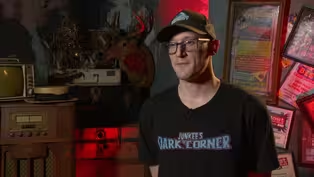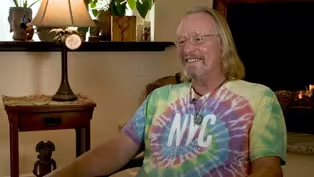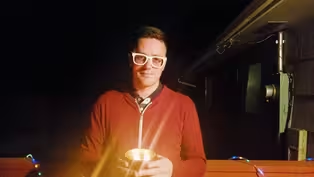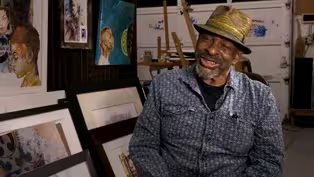ARTEFFECTS
Local Feature: Episode 813
Clip: Season 8 | 6m 28sVideo has Closed Captions
In this episode of ARTEFFECTS, meet artist and environmentalist Kyle Karrasch of Reno.
In this episode of ARTEFFECTS, see how Kyle Karrasch of Reno creates thought-provoking sculptures by utilizing aluminum cans, plastic bottles, and other discarded trash to send an important message.
Problems playing video? | Closed Captioning Feedback
Problems playing video? | Closed Captioning Feedback
ARTEFFECTS is a local public television program presented by PBS Reno
ARTEFFECTS
Local Feature: Episode 813
Clip: Season 8 | 6m 28sVideo has Closed Captions
In this episode of ARTEFFECTS, see how Kyle Karrasch of Reno creates thought-provoking sculptures by utilizing aluminum cans, plastic bottles, and other discarded trash to send an important message.
Problems playing video? | Closed Captioning Feedback
How to Watch ARTEFFECTS
ARTEFFECTS is available to stream on pbs.org and the free PBS App, available on iPhone, Apple TV, Android TV, Android smartphones, Amazon Fire TV, Amazon Fire Tablet, Roku, Samsung Smart TV, and Vizio.
Providing Support for PBS.org
Learn Moreabout PBS online sponsorship- Hello, I'm Beth McMillan, and welcome to ARTEFFECTS.
In our featured segment, we meet Kyle Karrasch of Reno.
This artist takes thousands upon thousands of aluminum cans, plastic bottles, and other discarded trash and gives it all a meaningful new life.
His goal?
To bring awareness to our collective consumption habits of single-use materials and inspire change along the way.
(lighthearted music) - I have a great passion for fishing.
It's nice on a wave.
It's just me out in nature, which I love.
My name is Kyle Karrasch.
I'm an artist, art educator, and I'm the Galleries Curator up at Truckee Meadows Community College.
I grew up here in Reno doing Boy Scouts.
In the Scouts, we spent a lot of time out in nature, camping, hiking, and the biggest thing I took away from the idea of being a Boy Scout was leave no trace.
(lighthearted music) I always bring a garbage bag with me.
I pick up garbage whatever I'm out.
I look at them as not just refuge things that have little to no value and they're just garbage 'cause they do have value.
There's a ton that goes into these materials.
The resources that went in just to even make that one object, just that aluminum can, like how much earth was strip-mined just to produce that aluminum, and now it's just sitting out on the side of a street or along the Truckee River.
(lighthearted music) It also makes me feel better about giving these materials a new lease on life.
(jaunty music) When most people ask me to describe what my artwork is, I just jokingly say, "It's garbage."
But then I say, "No, actually, my work is about materials of ubiquity within our contemporary life.
They're the objects of planned obsolescence."
So it's the single-use consumable materials that I incorporate in my artwork.
So a lot of aluminum, primarily, and then plastic, rubber, glass, and paper.
My wife jokes I'm kind of a garbage hoarder, but it's not to that extent.
It's all nice, neat, and organized.
It starts with the idea, writing out notes sometimes in my sketchbook, why I am using these materials, how I can manipulate those materials and these blueprints.
And then it comes down to acquiring the materials themselves.
I have a large stockpile that I've collected over the years, but it doesn't mean I always have every color.
So sometimes, I have to look for particular colors.
It can take a long time for me to build up a particular color palette that I want to use for a piece.
I also use a lot of people in the community for my really large-scale work.
If I need thousands of cans, I'm not producing that myself.
So every two weeks, I'll do a runaround town for people I know that collect their cans for me.
I do have a good network.
You've been a good producer.
- Yeah.
- Thank you very much.
- Tell me next time you need some more.
- Oh, you'll be hearing from me.
Once I've acquired enough of those materials to start actually making them usable and apply them to my work, it comes time to deconstruction process and materials, which I kind of liken to fileting out like the skins of a can.
I wanna make it a workable surface, so it's a little easier for me to work with.
I try to use as much as the can as possible.
Then whatever is scrapped and left over, I can shred down for either melting for some other objects I have in mind to do in the future or even saving just the barcodes.
(scissors snipping) What you see in my studio, I've got jars, and jars, and jars of just all these little pieces that didn't quite get used in one particular piece, but they're being saved for a future piece.
(jaunty music) I have a little hammer, which this hammer is, probably out of everything in my home, my favorite object 'cause it was my great-grandfather's little tack hammer.
It's like a little cobbler hammer.
(wood thudding) Other than using the little tacks, it's a lot of super glue.
My fingers are usually pretty rubbed because of how much glue gets on them.
I'll build a frame myself, and then once the frame's done, then that one wall piece is done.
I call them sculptures because they are three-dimensional.
A lot of people mistake them as paintings until they really get close up and realize what the material is.
I really like to use and create birds.
They're a good, I think, social criticism that we can use in art because they're the ultimate symbol of freedom.
Like, I think humanity's always dreamed of being able to fly since the dawn at time.
I think we've always envy birds for that, and that's why I like using them in my work.
Unfortunately, I'm portraying them as dead or decomposing mainly because of what we are doing to our environment and the decline in the North American bird population.
A lot of my larger scale works have to deal with data visualization of what we consume daily.
I had a huge wall of 12,000 condensed aluminum cans into cubes, and that really only equated to 3.4 seconds the US consumption.
So within 30 seconds, where 106,000 aluminum cans within three months, we've consumed so much we could rebuild the entire commercial air fleet.
We all contribute to this problem.
I do, everyone does, we can't help it.
To be human is consume.
So it's just thinking about the impact you're doing and that's what I really enjoy from the audience.
You're like, "Oh, wow, I didn't know about this," or, 'I'm gonna look into this."
I'm like, "Well, good.
Well, then that means, for me, my art was a success."
(mellow music) (mellow music) - [Announcer] Funding for ARTEFFECTS is made possible by Sandy Raffealli with Bill Pierce Motors.
(bright music) Meg and Dillard Myers.
Heidemarie Rochlin.
In memory of Sue McDowell.
And by the annual contributions of PBS Reno Members.
(bright music) (jazz music)
Video has Closed Captions
Clip: S8 | 6m 11s | In this story from ARTEFFECTS, explore the message of kindness from Reno Painted Rocks. (6m 11s)
Video has Closed Captions
Clip: S8 | 7m 12s | Meet Roberta Cota-Montgomery, "The Sugared Squirrel," a cookie artisan in Gardnerville, NV (7m 12s)
Video has Closed Captions
Clip: S8 | 6m | This segment features Copper Cat Studio, a healing arts studio. (6m)
Video has Closed Captions
Clip: S8 | 6m 28s | In this episode of ARTEFFECTS, meet artist and environmentalist Kyle Karrasch of Reno. (6m 28s)
Video has Closed Captions
Clip: S8 | 7m 27s | This segment features Matt Kauffmann whose art shares great creativity and colorful wonder (7m 27s)
Video has Closed Captions
Clip: S8 | 4m 14s | Mongolian-born artist Turburam Sandagdorj creates highly detailed paper silhouettes (4m 14s)
Video has Closed Captions
Clip: S8 | 7m 44s | This segment features Magique at The Theater, a big show with costumes and illusions. (7m 44s)
Video has Closed Captions
Clip: S8 | 5m 53s | This segment features Nicole King who creates stunning talisman jewelry. (5m 53s)
Video has Closed Captions
Clip: S8 | 6m 51s | Sabrina Frey uses hundreds of thousands of beads of all colors to create striking mosaics. (6m 51s)
Video has Closed Captions
Clip: S8 | 7m 47s | This segment features The Dark Corner Haunt, go behind the scenes and meet the artists. (7m 47s)
Video has Closed Captions
Clip: S8 | 7m 33s | Meet a woodcarver from Grass Valley, CA, who reveals nostalgia through craftsmanship (7m 33s)
Video has Closed Captions
Clip: S8 | 9m 28s | For this segment meet Reno Poet Laureate Dustin Howard. Listen to this amazing visual poet (9m 28s)
Video has Closed Captions
Clip: S8 | 5m 49s | In this ARTEFFECTS feature, meet watercolor artist James Gayles of Reno (5m 49s)
Providing Support for PBS.org
Learn Moreabout PBS online sponsorshipSupport for PBS provided by:
ARTEFFECTS is a local public television program presented by PBS Reno
